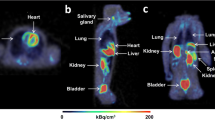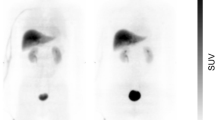Abstract
Using a multi slice whole body PET scanner PC4096-15WB, diagnostic measurements of the cerebral distribution of the D2 receptor ligand 3-N-([18F]fluoroethyl)spiperone were extended to quantify the biodistribution of this PET radiopharmaceutical. As a rotating line source was used for measured attenuation correction, transmission scans could be combined with emission scans even after injection of the tracer. Only 1 of the total administered dose (TAD) was found in the whole brain at 180 min, but the striatum and pituitary were still excellently delineated. Urinary bladder, gall bladder, and liver were the organs with the highest TAD ranging from 6% to 25%. The gall bladder is the critical organ with an absorbed dose of about 200 mGy/kBq followed by the urinary bladder and liver with 83 and 66 mGy/kBq, respectively. In the rest of the body radioactivity was evenly distributed. The total body dose was found to be 11.9 mGy/kBq.
Similar content being viewed by others
References
Attix FH (1986) Introduction to Radiological Physics and Radiation Dosimetry. Wileys, New York, pp 55–59
Bigler RE, Sgouros G (1983) Biological Analysis and Dosimetry for15O-Labeled O2, CO2, and CO Gases Administered Continuously by Inhalation. J Nucl Med 24:431–437
Budinger TIT (1974) Quantitative nuclear medicine imaging application of computers to the gamma camera and whole-body scanner. In: Lawrence JH (ed) Progress in atomic medicine, Vol. 4, recent advances in nuclear medicine. Academic, New York, pp 41–130
Carroll LR, Kretz P, Orcutt G (1983) The orbiting rod source: Improving performance in PET transmission correction scans. In: Emission computed tomography. Society of Nuclear Medicine, New York, pp 235–247
Carson RL, Daube-Witherspoon ME, Green MV (1988) A Method for Postinjection PET Transmission Measurements with a Rotating Source. J Nucl Med 29:1558–1567
Coenen HH, Laufer P, Stöcklin G, Wienhard K, Pawlik G, Böcher-Schwarz HG, Heiss W-D (1987) 3N-(F18)fluoroethylspiperone: A novel ligand for dopamine receptor studies with PET. Life Sci 40:81–88
Coenen HH, Wienhard K, Stöcklin G, Laufer P, Hebold I, Pawlik G, Heiss WD (1987) PET measurement ofD 2 andS 2 receptor ligand binding of 3-N-([2′-18F]fluoroethyl)spiperone in baboon brain. Eur J Nucl Med 14:80–87
Harvey J, Firnau G, Garnett ES (1985) Estimation of the radiation dose in man due to 6-[18F]fluoro-L-dopa. J Nucl Med 26:931–935
Herzog H, Spohr G, Notohamiprodjo G, Feinendegen LE (1987) Absolute quantification of pharmacokinetic distribution of RES colloids in individuals with normal liver function. Nucl Med Commun 8:157–175
Holte S, Eriksson L, Larsson JE, Ericson T, Stjernberg H, Hansen P, Rota E, Herzog H, Feinendegen LE (1988) A preliminary evaluation of a positron camera system using weighted decoding of individual crystals. IEEE Trans Nucl Sci NS-35: 730–733
IRCP (1975) International Commission on Radiological Protection: Report of the task group on reference man, ICRP-Publication No. 23. Annals of the ICRP, New York, pp 325–327
Jones SC, Alavi A, Christman D (1982) The radiation dosimetry of 2-[18F]fluoro-2-deoxy-D-glucose in man. J Nucl Med 23:613–617
Kearfott KJ (1982a) Absorbed Dose Estimates for Positron Emission Tomography (PET): C15O,11CO, and CO15O. J Nucl Med 23:1031–1037
Kearfott KJ (1982b) Radiation Absorbed Dose Estimates for Positron Emission Tomography (PET): K-38, Rb-81, Rb-82, and Cs-130. J Nucl Med 23:1128–1132
Kaerfott KJ, Junck L, Rottenberg DA (1983) C-11 Dimethyloxazolidinedione (DMO): Biodistribution, Radiation Absorbed Dose, and Potential for PET Measurement of Regional Brain pH: Concise Communication. J Nucl Med 24:805–811
Kiesewetter DO, Eckelman WC, Cohen RM, Finn RD, Larson SM (1986) Syntheses andD 2 receptor affinities of derivatives of spiperone containing aliphatic halogens. Appl Radiat Isot 37:11–81
Krahwinkel W, Herzog H, Feinendegen LE (1988) Pharmacokinetics of Thallium-201 in Normal Individuals After Routine Myocardial Scintigraphy. J Nucl Med 29:1582–1586
Lockwood AH (1980) Absorbed Doses of Radiation After An Intravenous Injection of N-13 Ammonia in Man: Concise Communication. J Nucl Med 21:276–278
Mayneord WV (1945) Energy absorption. IV: The mathematical theory of integral dose in radium therapy. Br J Radiol 18:12
Meyer E, Yamamoto LY, Evans AC, Tyler JL, Diksic M, Feindel W (1987) Radiation Dose to Upper Airways from Inhaled Oxygen-15 Carboan Dioxide. J Nucl Med 28:234–239
Satamurthy N, Bida GT, Barrio JR, Luxen A, Mazziotta JC,Huang SC, Phelps ME (1986) No-carrier-added 3-(2′-[18F]fluoroethyl)spiperone, a new dopamine receptor-binding tracer for positron emission tomography. Nucl Med Biol 13:617–624
Sorenson JA (1974) Quantitative measurement of radioactivity in vivo by whole-body counting. In: Hine GJ, Sorenson JA (eds) Instrumentation in nuclear medicine, Vol. 2. Academic, New York, pp 311–347
Snyder WS, Ford MR, Warner GG, Watson SB (1975) “S” absorbed dose per unit cumulated activity for selected radionuclides and organs. MIRD Pamphlet No. 11, Society of Nuclear Medicine, New York
Thompson CJ, Dagher A, Lunney DN (1986) A technique to reject scattered radiation in PET transmission scans. In: Nalcioglu O, Cho ZH, Budinger TF (eds) International workshop on physics and engineering of computerized multidimensional imaging and processing. Proc SPIE 617:244–253
Thonoor CM, Couch MW, Greer DM, Thomas KD, Williams CM (1988) Biodistribution and radiation dosimetry of radioiodinated-SCH 23982, a potential dopamineD 1 receptor imaging agent. J Nucl Med 29:1668–1674
Welch MJ, Chi DY, Mathias CJ, Kilbourn MR, Brodack JW, Katzenellenbogen JA (1986) Biodistribution of N-alkyl and Nfluoroalkyl derivates of spiroperidol; radiopharmaceuticals for PET studies of dopamine receptors. Nucl Med Biol 13:523–526
Welch MJ, Katzenellenbogen JA, Mathias CJ, Brodack JW, Carlson KE, Chi DY, Dence CS, Kilbourn MR, Perlmutter JS, Raichle ME, Ter-Pogossian MM (1988) N-(3-[18F]Fluoropro-pyl)spiperone: the preferred18F labeled spiperone analog for positron emission tomographic studies of the dopamine receptor. Nucl Med Biol 15:83–97
Author information
Authors and Affiliations
Rights and permissions
About this article
Cite this article
Herzog, H., Coenen, H.H., Kuwert, T. et al. Quantification of the whole-body distribution of PET radiopharmaceuticals, applied to 3-N-([18F]fluoroethyl)spiperone. Eur J Nucl Med 16, 77–83 (1990). https://doi.org/10.1007/BF01465913
Received:
Revised:
Issue Date:
DOI: https://doi.org/10.1007/BF01465913




